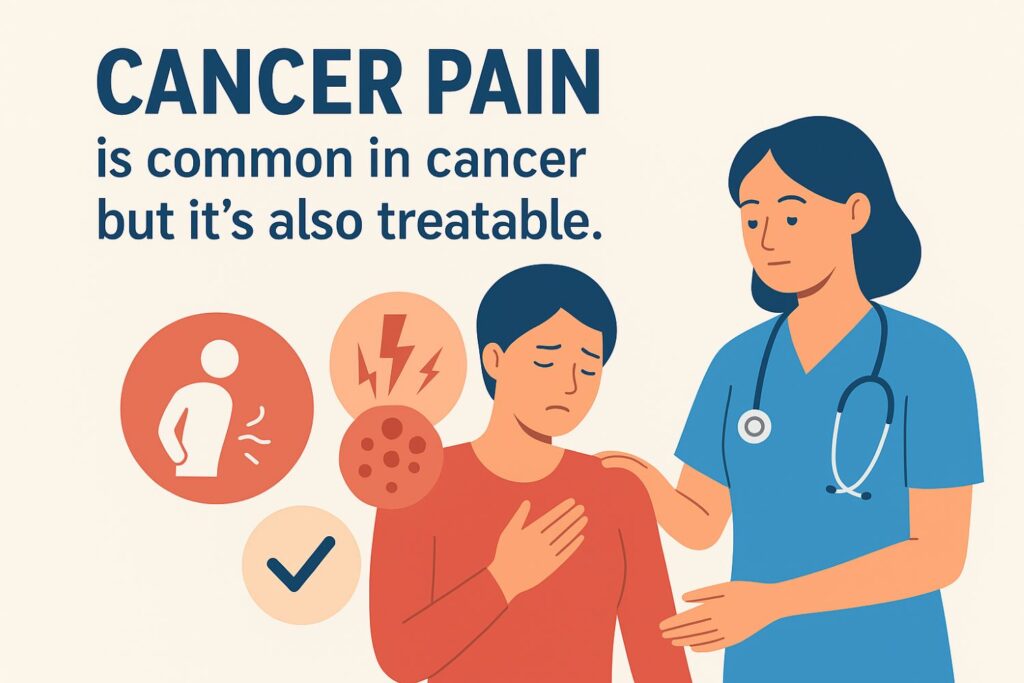Pain is common in cancer – but it’s also treatable. This blog pulls together what the strongest evidence and major guidelines say about assessing and managing pain during active cancer treatment (surgery, chemo, radiation, targeted or immunotherapy).

How common is cancer pain during treatment?
- Large meta-analyses show ~40–55% of people experience pain while receiving anticancer therapy. Moderate–severe pain remains common, though recent data suggest modest improvement with better assessment and management.
- Prevalence varies by cancer type and stage (higher with advanced disease) and by setting (higher in inpatient and palliative settings).
What drives pain during treatment?
- Surgery: incisional pain; nerve injury syndromes (e.g., post-thoracotomy, post-mastectomy) in some.
- Chemotherapy/targeted therapy: neuropathic pain (e.g., CIPN), mucositis, arthralgias/myalgias (e.g., aromatase inhibitors).
- Radiation: mucositis, dermatitis, post-radiation fibrosis/neuropathic pain.
- Cancer itself: bone metastases, visceral/organ capsule stretch, nerve/plexus compression, obstruction.
- Breakthrough cancer pain (BTcP): transient spikes of severe pain on top of baseline control, often triggered by movement or procedures.
Start with excellent assessment (every visit)
- Ask at every encounter. Use a 0–10 numeric rating and focus on how pain limits function (sleep, mobility, mood).
- Use quick, validated tools to track change:
- Brief Pain Inventory (BPI) for intensity and interference.
- Edmonton Symptom Assessment System (ESAS) to monitor multiple symptoms alongside pain.
- Clarify pain mechanism (nociceptive, neuropathic, mixed), pattern (constant vs. breakthrough), and red flags (e.g., new weakness, cord compression, bowel/bladder changes, infection).
- Document current/previous analgesics, adjuvants, and side-effects; screen for risk factors for opioid-related harms (sleep apnea, renal/hepatic impairment, drug interactions, substance use history).
The treatment backbone: multimodal, mechanism-based care
Modern guidelines build on (and refine) the classic WHO analgesic ladder:
1) Non-opioid foundation (for all pain severities unless contraindicated)
- Paracetamol/acetaminophen (watch total daily dose).
- NSAIDs for inflammatory/bone pain (consider GI/renal/cardiac risks; use PPI when indicated).
- Topicals (lidocaine patch/gel) for localized neuropathic or post-surgical pain.
2) Target neuropathic pain early
- Duloxetine has the best evidence for painful chemotherapy-induced peripheral neuropathy (CIPN).
- Gabapentinoids (gabapentin/pregabalin) or tricyclics (e.g., nortriptyline) can help other neuropathic syndromes; titrate thoughtfully and reassess benefit.
3) Opioids (when pain remains moderate–severe or functionally limiting)
- Remain a first-line option for moderate–severe cancer pain when used carefully.
- Start with immediate-release to find the right dose, then consider long-acting for persistent daily pain.
- Prescribe breakthrough doses (~10% of the total daily opioid) for BTcP.
- Always pair with a constipation plan (stimulant ± osmotic laxative from day one).
4) Disease-directed and targeted pain therapies
- Palliative radiotherapy is one of the most effective analgesics for painful bone metastases; a single 8 Gy fraction is often as effective as multi-fraction schedules for pain relief (discuss re-treatment risk and logistics).
- Bone-modifying agents (bisphosphonates or denosumab) reduce skeletal-related events and can lessen bone pain over time in metastatic disease.
- Steroids (e.g., dexamethasone) can temporarily relieve pain from capsular stretch, nerve compression, or brain/spinal edema—use short courses and taper.
- Interventional options for refractory focal pain:
- Celiac plexus neurolysis for pancreatic cancer pain can reduce opioid needs and improve pain.
- Other blocks/neuraxial or intrathecal approaches are appropriate in specialist hands for selected patients.
5) Integrative and rehabilitative strategies (evidence-based)
- Acupuncture can reduce some treatment-related pains (e.g., aromatase-inhibitor arthralgias) and may help with general cancer pain in some settings.
- Mind–body therapies (relaxation, guided imagery, hypnosis), massage, and structured exercise/physical therapy improve pain interference and function for many patients.
- Encourage sleep optimization, pacing of activity, heat/ice where appropriate, and assistive devices to maintain mobility and independence.
Breakthrough cancer pain (BTcP): don’t miss it
- Reassess the baseline regimen first (is the background dose adequate?).
- Use fast-onset rescue medicines (short-acting opioid options) timed to triggers (e.g., before dressing changes or physiotherapy).
- For frequent BTcP, up-titrate the scheduled baseline analgesic and re-evaluate.
Safety and stewardship (what good opioid care looks like)
- Discuss goals, benefits/risks, and expected side-effects up front.
- Use the lowest effective dose, avoid risky combinations (e.g., benzodiazepines) when possible, and review drug–drug interactions (e.g., with targeted/antiemetic agents).
- Co-prescribe naloxone when risk is elevated; educate on safe storage and proper disposal.
- Reassess regularly; taper if harms outweigh benefits or pain improves with disease control.
When to escalate or refer
- Uncontrolled pain despite optimized multimodal therapy.
- Mechanism-specific candidates for procedures (e.g., pancreatic pain, vertebral metastases).
- Complex neuropathic syndromes, intolerable side-effects, or major psychosocial barriers.
- Early palliative care integration improves symptom control and quality of life and should run in parallel with active oncology care.
Equity matters
- Studies repeatedly show racial/ethnic and socioeconomic disparities in cancer pain treatment and opioid prescribing. Build safeguards: use standardized assessment tools, apply protocols, audit your own prescribing, and invite shared decision-making that respects patient preferences and concerns.
A quick checklist for clinic days
Assess: BPI score + functional limits + BTcP?
Classify: nociceptive vs neuropathic vs mixed; red flags?
Treat: non-opioid base → add neuropathic agent → judicious opioid if needed + laxatives
Target: consider RT, bone-modifiers, steroids, or blocks for mechanism-specific pain
Support: integrative therapies, PT/OT, sleep, mood support
Safety: interactions, naloxone where appropriate, storage/disposal, follow-up date set
Note: This blog is educational and does not replace medical advice. Care should be tailored to patient goals, comorbidities, and local regulations.
References:
- International Association for the Study of Pain (IASP). Pain Awareness Month. (IASP)
- van den Beuken-van Everdingen MHJ, et al. Update on Prevalence of Pain in Patients With Cancer: Systematic Review and Meta-analysis. J Pain Symptom Manage. 2016;51(6):1070-1090.e9. doi:10.1016/j.jpainsymman.2015.12.340. (PubMed)
- Snijders RAH, et al. Update on Prevalence of Pain in Patients with Cancer 2022: A Systematic Review and Meta-Analysis. Cancers (Basel). 2023;15(3):591. doi:10.3390/cancers15030591. (PMC, MDPI)
- Evenepoel M, et al. Pain Prevalence During Cancer Treatment: A Systematic Review and Meta-Analysis. J Pain Symptom Manage. 2022;63(5):e477-e493. (jpsmjournal.com)
- Fallon M, et al. Management of cancer pain in adult patients: ESMO Clinical Practice Guidelines. Ann Oncol. 2018;29(Suppl 4):iv166-iv191. (Annals of Oncology)
- NCCN Guidelines Insights: Adult Cancer Pain, Version 2.2025. JNCCN. 2025. (Guideline update summarizing key recommendations for assessment and multimodal management.) (Cochrane Library)
- Paice JA, et al. Use of Opioids for Adults With Pain From Cancer or Cancer Treatment: ASCO Guideline Update. J Clin Oncol. 2023. (Guideline on safe and effective opioid use in oncology.) (ASCOPubs)
- Mao JJ, et al. Integrative Oncology: Pain Management in Adults with Cancer (ASCO–SIO Guideline). J Clin Oncol. 2022. (Evidence-based recommendations for acupuncture, massage, mind–body therapies, and exercise.) (ESMO)
- Smith EM, et al. Effect of Duloxetine on Painful Chemotherapy-Induced Peripheral Neuropathy. JAMA. 2013;309(13):1359-67. (NCBI)
- Hartsell WF, et al. Randomized Trial of Short- vs Long-Course External Beam Radiotherapy for Painful Bone Metastases. J Natl Cancer Inst. 2005;97(11):798-804. (JPain)
- Wyse JM, et al. Randomized, Double-Blind, Controlled Trial of Early Endoscopic Ultrasound–Guided Celiac Plexus Neurolysis for Pain in Pancreatic Cancer. J Clin Oncol. 2011;29(26):3541-3546. (ASCOPubs)
- Nagels W, et al. Celiac Plexus Neurolysis for Pancreatic Cancer Pain: A Systematic Review. Pain Pract. 2013;13(5):356-367. (Oncology Nursing Society)
- Cleeland CS, Ryan KM. Pain assessment: global use of the Brief Pain Inventory. Ann Acad Med Singap. 1994;23(2):129-38. (Original BPI development/validation lineage.) (ASCOPubs)
- Watanabe SM, et al. A Multicenter Study Comparing Two Numerical Versions of the ESAS. Support Care Cancer. 2011;19(3):405-412. (ESAS update/validation.) (ASCOPubs)
- Meghani SH, Byun E, Gallagher RM. Time to Take Stock: A Meta-analysis and Systematic Review of Racial/Ethnic Disparities in Analgesic Treatment for Pain in the United States. Pain Med. 2012;13(2):150-174. (Oxford Academic, PubMed)
- Vitzthum LK, et al. Racial, Ethnic, and Socioeconomic Discrepancies in Opioid Prescribing during Cancer Treatment. Oncologist. 2021;26(11):e2073-e2080. (PMC)


